Correcting Neck Posture: A Key To Pain Relief
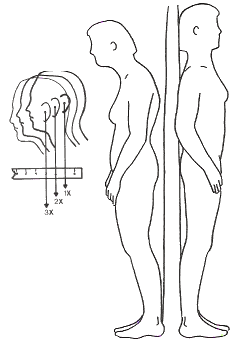 Poor neck posture leads to a Forward Head Position which is one of the most common causes of neck, head and shoulder tension and pain.
Poor neck posture leads to a Forward Head Position which is one of the most common causes of neck, head and shoulder tension and pain.
This can be a result of injuries like sprains and strains of the neck leading to weak neck muscles, problems sleeping positions and contribute to driving stress, neck related headaches, couch neck, readers neck, text neck, military neck, along with improper breathing habits.
Poor Neck Posture – Why Does It Hurt So Much ?
For every inch that the head moves forward in posture, it increases the weight of the head on the neck by 10 pounds!
A forward posture of 3 inches increases the weight of the head on the neck by 30 pounds and the pressure put on the muscles increases 6 times.
Long term abnormal cervical spine posture leads to straining of muscles, disc herniations, arthritis, pinched nerves and instability.
Poor health can result from stretching of the spinal cord. A major part of head, neck, jaw and shoulder pain is due, at least in part, to the effects of poor posture including fibromyalgia syndrome, myofascial pain syndrome, temporomandibular joint dysfunction and chronic fatigue syndromes.
The extra pressure on the neck from altered posture flattens the normal curve of the cervical spine resulting in abnormal strain of muscles, ligaments, bones and joints of the neck causing the joints to deteriorate faster than normal resulting in degenerative joint disease or spondylosis of the cervical spine and facet joint problems.
Effects Of Poor Neck Posture
Posture is crucial part of normal balance and health. Many postural factors are involved in causing spasms of the neck, shoulders and back muscles, reducing healthy biomechanical function, and weakening soft tissues. These consist of forward head posture, largely due to popular use of computers, sitting at a computer or desk for extended periods, using chairs and desks that are not appropriate for the body type, a non-supportive mattress sustaining poor posture throughout sleep, deconditioning from lack of reasonable activity or exercise, increased emphasis on learning activities considered to be excessive as well as school bags that are too heavy.
Forward head posture is probably the most common posture deviations for individuals suffering neck pain. Individuals with neck and shoulder problems have greater forward head posture than those without these problems.
The effects of poor posture goes far beyond just looking awkward. Posture and function are related in that poor posture is evident in patients with chronic pain related conditions including low back pain, headaches, and stress-related illnesses. Posture affects and moderates every function from breathing to hormonal production. Spinal pain, headache, mood, blood pressure, pulse and lung capacity are among the functions most easily influenced by poor posture.
| Some Common Causes of Poor Neck Posture | |||
 Driving Stress |
 Computer Neck |
 Couch Neck |
 Readers Neck |
According to the Mayo Clinic Health Letter Vol. 18, #3, March 2000, the effects of long term forward neck posture leads to “long term muscle strain, disc herniations and pinched nerves.”
A 2020 study in the Journal of Orthopaedic Surgery and Research indicated cervical alignment is closely related with disc degeneration and impacts spinal function. The authors found a significant effect of loss or reversal of curve on the occurrence of axial neck pain.
A 2020 study in the International Journal of Occupational Medicine & Environmental Health indicates the head is approximately 6% of the total body weight. The study proved the position of the head affect muscle activity, proprioception (awareness or perception of body movement and position), breathing patterns and neck pain.
A 2021 Study In Human Factors found that head-neck posture is the most significant factor in both neck strength and endurance.
Can You Change The Posture Of Your Neck ?
Correction of poor posture is key to stopping and reversing the decay and degeneration that neck structures undergo and problems that can result including neck pain symptoms, tension and migraine headaches and pain between the shoulders.
When the spinal tissues are subject to significant pressure for long periods of time, they deform and undergo a remodeling in which these changes can become permanent. This is why it takes time and a concerted effort using multiple techniques to correct the poor posture condition. Although it requires a multifactorial approach, there are some things you can do we call posture first aid.
Abnormal cervical posture is associated with sympathetic symptom of degeneration which may include; headaches, abnormal functions of the eyes and the ears, and psychological and mental disorders.
 Self Test for Neck Posture Problems: The Wall Test – Stand with the back of your head touching the wall and your heels six inches from the baseboard. With your buttocks touching the wall, check the distance with your hand between your neck and the wall. If you can get within two inches at the neck, you are close to having good posture. If not, your head is protruding forward and is subject to deterioration of the joints and discs. |
According to the 31st Annual International Conference of the IEEE EMBS Minneapolis, Minnesota, USA, September 2-6, 2009; “Over time poor posture results in pain, muscle aches, tension and headache and can lead to long term complications such as osteoarthritis. Physiological and biomechanical stress due to sustained postures limit important musculoskeletal stimuli that are essential for normal musculoskeletal development”.
Solutions:
Awareness of the correct neck and shoulder posture is the beginning of correction. Do the wall test as described above. You can check someone you care about by standing straight and having them look up at the ceiling, down at the floor and then straight ahead. Picture an imaginary line through the center of the shoulder and up to the head. The line should land through the middle of the ear.
A crucial part of correcting posture is the nodding neck exercises which are designed to help gain control over postural neck muscles which have become weak and fatigued over time. These tend to be deep muscles that are responsible for maintaining good posture which are often overlooked in exercise/stretching programs. Ther video below can get you started at the beginner level.
For office use and video game play, place your computer monitor height so that the top third of the screen is even with your eyes and the screen is 18-24 inches from your face. It is important to learn more about postural ergonomics
Take frequent breaks. If you sit for long periods, take frequent breaks, even if only for 30 seconds to get up or do the neck exercises. Pull your head over your shoulders and squeeze the blades of your shoulders together in the back.
Maintaining correct posture is not just for the neck. Alignment of the back is important as well, and this can effect the neck and shoulders. A November, 2014 issue of the Journal of Physical Therapy Science featured a study where the authors found that sitting with the legs crossed for more than 3 hours a day can cause shoulder tilt and forward head posture.
Always use a back support pillow when sitting or driving if your seats are not designed properly to support the spine. By supporting the back, the head and neck will move back over the shoulders. If you have difficulty finding a back support that works for you, the Active Seat Cushion can help activate certain muscles to help support better posture for sitting and prevent muscle fatigue.
In the journal Work. Volume 36, Number 1 / 2010, an article titled “Effect of different seat support characteristics on the neck and trunk muscles and forward head posture of visual display terminal workers”, indicates an unstable seat cushion relaxes neck muscles and improves posture better than a spongy soft-cushion seat support. The article further states that this type of seat cushion may prevent work-related neck and upper limb disorders associated with forward head posture.
Many backpacks are improperly designed and/or overweighted, and cause the head to move forward to compensate for weight in the back. Make sure you and/or your kids use properly designed backpacks that distribute weight evenly and help to prevent strain that begins the process of poor neck posture.
According to a February, 2009 issue of the international journal Cephalalgia, “We found a concerning association between neck pain and high hours of computing for school students, and have confirmed the need to educate new computer users (school students) about appropriate ergonomics and postural health.”
Another February, 2009 article in Cephalalgia noted in regard to Respiratory Dysfunction In Chronic Neck Pain Patients; … “the study demonstrated a strong association between an increased forward head posture and decreased respiratory muscle strength in neck patients.”
A 2021 study in the Journal of Orthopaedic Surgery and Research noted cervical spinal alignment plays a key role in the causation of neck pain, associated functional disability and poor quality of life. This imbalance often leads to serious degenerative disease. The correct posture is important for maintaining global sagittal balance and preventing neck pain.
A 2022 study in the Journal of Clinical Medicine found that correcting cervical posture had a positive impact on spinal posture parameters, leg and back pain scores, as well as disability due to chronic discogenic lumbosacral radiculopathy.
 The use of specialized equipment like home traction devices are essential to and effective in restoring the normal curve of the neck. This can greatly enhance the process to posture recovery. regarding the relationship of changes in neck posture in patients with neck pain; as neck pain patients have the normal neck curve restored over a twelve week period, improvements are often noted in measurements of clinical symptoms. Improvements are indicated by the Visual Analog Scale (a pictorial representation), Neck Disability Questionnaire, and Pain Pressure Algometry measurements which correlate with an increase in the degree of curvature of the cervical spine.
The use of specialized equipment like home traction devices are essential to and effective in restoring the normal curve of the neck. This can greatly enhance the process to posture recovery. regarding the relationship of changes in neck posture in patients with neck pain; as neck pain patients have the normal neck curve restored over a twelve week period, improvements are often noted in measurements of clinical symptoms. Improvements are indicated by the Visual Analog Scale (a pictorial representation), Neck Disability Questionnaire, and Pain Pressure Algometry measurements which correlate with an increase in the degree of curvature of the cervical spine.
Choosing a supportive cervical pillow is very important since we spend about a third of our time sleeping. This time can be used to help your neck posture rather than hurt it with proper pillow support like a functional pillow.
If you have a chronic condition like arthritis, cartilage enhancing supplements should also be a part of your long term approach to correcting poor posture.
Additionally, I highly recommend Chiropractic Care and you should not hesitate to see one as proper adjustments of the neck joints have proven benefit.
At NeckSolutions, we hope to provide some quality advice and neck pain relief products so that you should be able to effect enough change over a period of time to correct these problems.

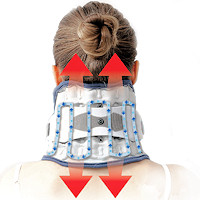 Neck Traction Devices
Neck Traction Devices Cervical Pillows
Cervical Pillows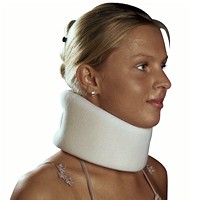 Neck Support Collars
Neck Support Collars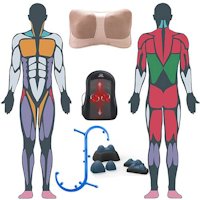 Muscle Therapy Tools
Muscle Therapy Tools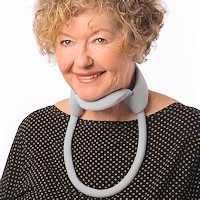 Head Supports
Head Supports Topical Pain Relievers
Topical Pain Relievers TENS Therapy
TENS Therapy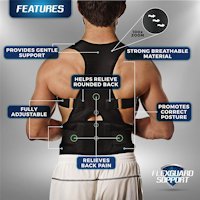 Posture Braces
Posture Braces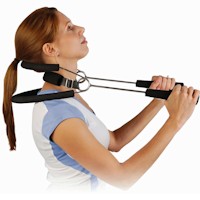 Neck Stabilization
Neck Stabilization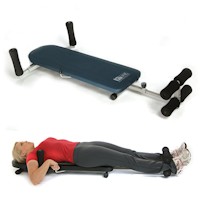 Traction & Inversion
Traction & Inversion Supports & Cushions
Supports & Cushions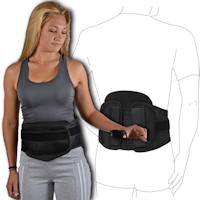 Belts & Corsets
Belts & Corsets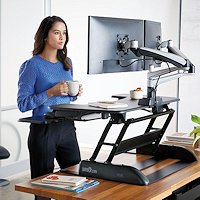 Ergonomic Aids
Ergonomic Aids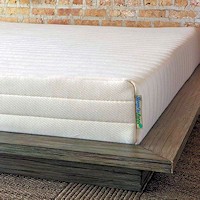 New Mattresses
New Mattresses Relief Supplements
Relief Supplements